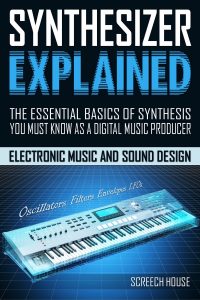What exactly is an envelope target and why do you need to know how to make a volume, panning, filter and pitch envelope? Here’s the answer…
The envelope target function is an essential part of a (subtractive) synthesizer that you can usually find in the envelope area.
What are envelopes?
An envelope is a function on a synthesizer where you can create sound movements. The movement can take many shapes or forms, depending on your design. Thereby, you can create different types of movements, such as a volume movement, panning movement, pitch movement or filter movement. But also, you can determine when the movement should happen and how extreme the movement should be.
So for example, you could use a volume envelope to give your sound a quick fade-in and fade-out. Or you could use a pitch envelope to slightly move up the tone of your sound. This way, you can set your sound in motion very flexibly, depending on the effect you wish to produce. Thus, it’s very important to understand all the settings on the envelope area, such as the envelope target.
How to use envelope target
An envelope target, also called destination, defines the sound movement. It dictates which knob has to move. So, by setting the target you choose upfront which type of movement you wish to create. There are usually many targets to choose from, but the most common ones are volume, panning, pitch, filter cutoff and filter resonance.
So, in order to make a sound movement, you always must select a target. Thereby, if you want to create a volume movement, select volume. If you want to have a pitch movement, select pitch. And so on.
You need more than an envelope target
Now, selecting a target on itself doesn’t create a movement. Thus, you won’t notice any effect. That’s why, to set your sound in motion, you will have to use the other envelope options, which we will explore next in the complete “Synthesizer for beginners” series.
Synthesizer for beginners
The “Synthesizer for Beginners” series is a huge collection of quick lessons about sound design and synthesis. Each lesson explains one part of how a subtractive synthesizer works, which is vital to know if you’re an electronic music producer.
Most people have the attention span of a butterfly and therefore miss all the important tips later in my videos and posts. Still, I don’t want you to miss a thing and that’s why you will see these short clips on Screech House. Each short clip explains a bite-sized topic from one of my longer videos. This gives everyone the chance to focus solely on what they need and thereby also saving a lot of time.
Today’s short clip is from the 4-part “Synthesizer Explained” video course. Watch the full episodes here:
Synthesizer explained!
The “Synthesizer Explained” video course is now finally available as an exclusive guide. This easy-to-read book is jam-packed with valuable info about the essential basics of sounds design, including practical tips and bonus cheat sheets.
Since the day of release, many people have already read it. But if you haven’t, click this link to get your copy: Synthesizer Explained.
Make sure to get it now, else you risk being too late and miss out.

